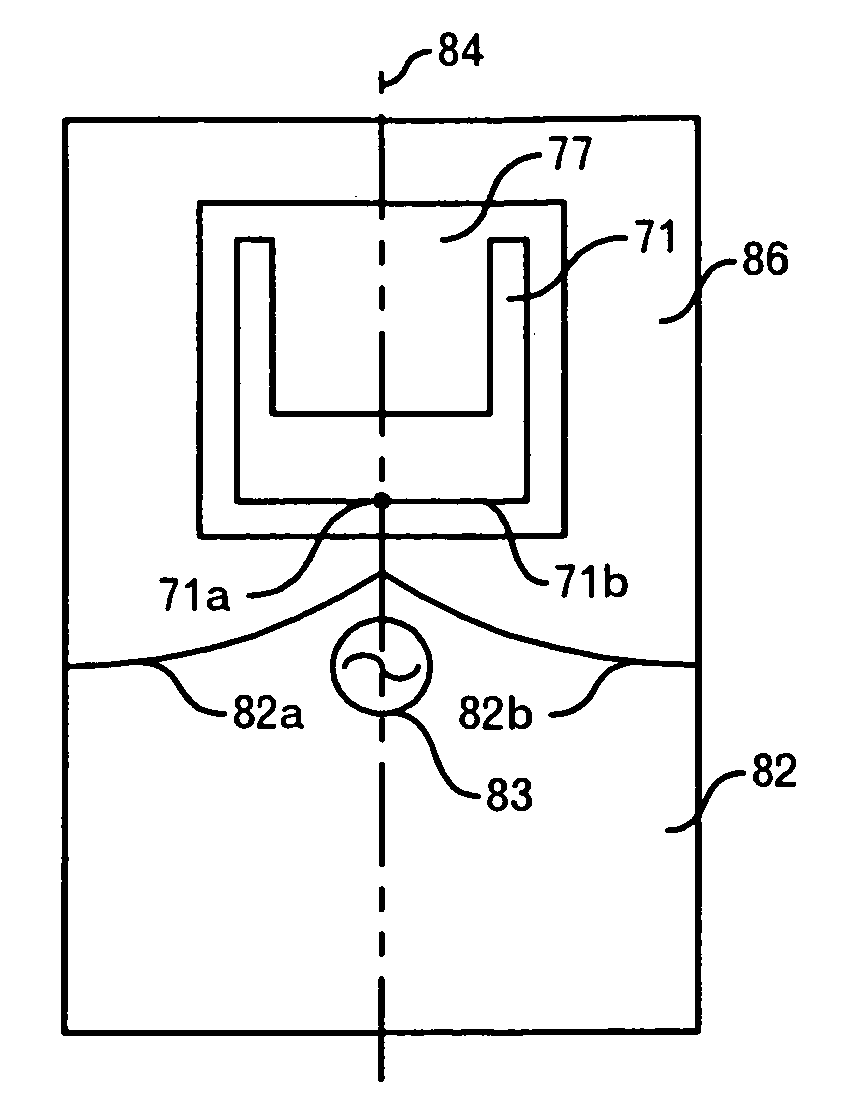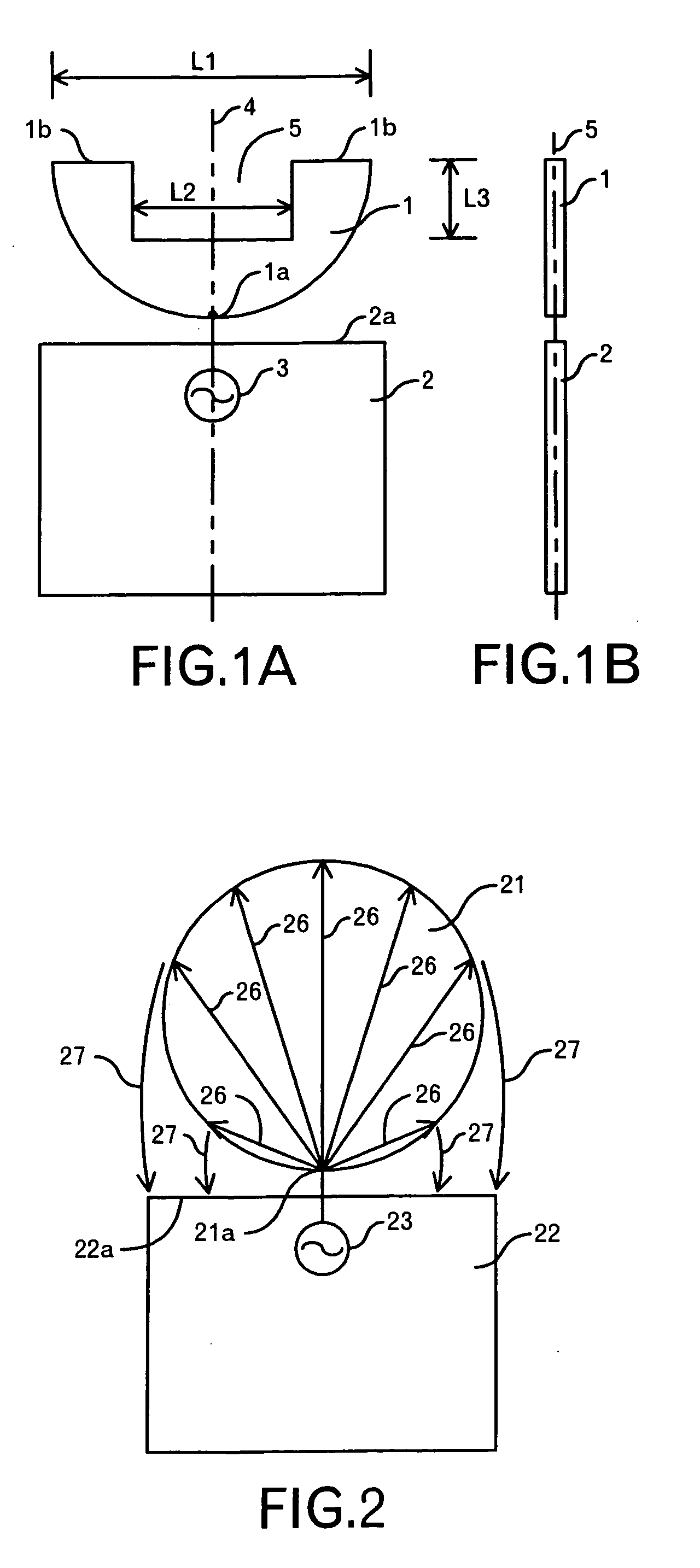Antenna and dielectric substrate for antenna
a dielectric substrate and antenna technology, applied in the direction of resonant antennas, antenna earthings, elongated active element feeds, etc., can solve the problems of difficult control of antenna characteristics, bad vswr characteristics, difficult to control antenna characteristics, etc., to achieve the effect of reducing the volume of the antenna, enhancing the miniaturization, and controlling the antenna characteristi
- Summary
- Abstract
- Description
- Claims
- Application Information
AI Technical Summary
Benefits of technology
Problems solved by technology
Method used
Image
Examples
first embodiment
[0053] Preferred embodiments according to the present invention will be described with reference to the accompanying drawings. [0054] 1. First Embodiment
[0055] The structure of an antenna according to a first embodiment of the present invention is shown in FIG. 1A and FIG. 1B. The antenna according to this embodiment is composed of a planar element 1 formed of a semicircular conductive flat plate and having a cut-out portion 5, a ground pattern 2 juxtaposed with the planar element 1, and a high-frequency power source 3 connected to the feed point 1a of the planar element 1. The diameter L1 of the planar element 1 is set to 20 mm, for example. The aperture L2 of the cut-out portion 5 is set to 10 mm, for example, and the rectangular concavity whose depth is L3 (=5 mm) is formed from the top portion 1b (i.e. the edge portion farthest from the feed point 1a) of the planar element 1 toward the ground pattern 2 side, for example. The feed point 1a is located at such a position that the ...
second embodiment
[0070] Furthermore, the shape of the cut-out portion 5 is not limited to the rectangular shape. For example, an inverted triangular cut-out portion 5 may be used. In this case, the feed point 1a and one apex of the inverted triangle are arranged to be located on the line 4. Still furthermore, the cut-out portion 5 may be designed in a trapezoidal shape. In the case of the trapezoid, if the bottom side is designed to be longer than the top side, the detour length at which the current path detours around the cut-out portion 5 is increased. Accordingly, the current path in the planar element 1 can be more increased. The corners of the cut-out portion 5 may be rounded. [0071] 2. Second Embodiment
[0072]FIG. 6 shows the structure of an antenna according to a second embodiment of the present invention. In this embodiment, an example will be explained in which a planar element 41 which is formed of a semicircular conductive flat plate and is equipped with a cut-out portion 45, and a ground...
third embodiment
[0076]FIG. 7 is a graph showing the impedance characteristic of the antenna according to this embodiment. In FIG. 7, the axis of ordinate represents VSWR and the axis of abscissa represents the frequency (GHz) Since the frequency bandwidth in which VSRW is not more than 2.5 extends from about 2.9 GHz to about 9.5 GHz, this embodiment has achieved a wide bandwidth antenna. The value of VSWR approaches 2 at about 6 GHz, however, this is permissible. The frequency at which VSWR becomes 2.5 is an extremely low frequency (i.e. about 2.9 GHz) because the cut-out portion 45 is provided. [0077] 3. Third Embodiment
[0078]FIG. 8 shows the structure of an antenna according to a third embodiment of the present invention. In this embodiment, an example will be explained in which a planar element 51 which is formed of a rectangular conductive flat plate and equipped with a cut-out portion 55, and a ground pattern 52 are formed on a printed circuit board (FR-4, Teflon (registered trademark) or the...
PUM
 Login to View More
Login to View More Abstract
Description
Claims
Application Information
 Login to View More
Login to View More - R&D
- Intellectual Property
- Life Sciences
- Materials
- Tech Scout
- Unparalleled Data Quality
- Higher Quality Content
- 60% Fewer Hallucinations
Browse by: Latest US Patents, China's latest patents, Technical Efficacy Thesaurus, Application Domain, Technology Topic, Popular Technical Reports.
© 2025 PatSnap. All rights reserved.Legal|Privacy policy|Modern Slavery Act Transparency Statement|Sitemap|About US| Contact US: help@patsnap.com



